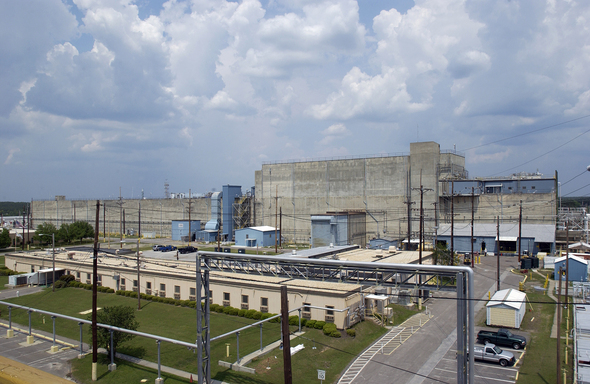Savannah River Site’s H Canyon Begins 2012 with New and Continuing Missions
Transuranic waste remediation, new mission work are the focus of the nation’s only active nuclear chemical separations facility in 2012
AIKEN, S.C. – The Savannah River Site (SRS) is breathing new life into the H Canyon, the only active nuclear chemical separations facility still operating in the U.S.
“After a history of primarily dissolving and separating materials found in irradiated reactor fuel rods, H Canyon continues to diversify its scope of work,” said DOE Savannah River Operations Office Manager David Moody. “H Canyon is a huge and dynamic production facility that continues to service the nation’s nuclear needs and does it safely. It is one of the key facilities in the site’s Enterprise SRS strategic vision.”
Enterprise SRS is an initiative launched last year to transform past environmental liabilities into revitalized assets for future use, including national security, clean energy development, and environmental management.

H Canyon, above, and HB-Line are scheduled to soon begin dissolving and purifying plutonium currently stored at the Savannah River Site to demonstrate the capability to produce oxide material that meets the Mixed Oxide Facility (MOX) feedstock specifications. The production process at MOX, which is now under construction, will eventually create fuel pellets for U.S. commercial reactor fuel assemblies.
New Mission for H Canyon
Excess plutonium in the U.S. has been consolidated at SRS and is currently stored within a highly secure structure at the site. This plutonium will eventually be processed at the site’s Mixed Oxide Facility (MOX), which is currently under construction. The MOX production process will remove impurities from the stored plutonium and mix it with uranium oxide to form MOX fuel pellets for reactor fuel assemblies. When operational, this facility will be capable of turning 3.5 metric tons of plutonium into reactor fuel assemblies annually. Studies are underway to determine the optimum means to supply the feedstock to the MOX.
According to Savannah River Nuclear Solutions (SRNS) H Canyon Facility Manager Mike Lewczyk, H Canyon and HB-Line, which is a sister facility also located in H Area, are scheduled to soon begin dissolving and purifying a quantity of the stored plutonium to demonstrate the capability of producing oxide material that meets MOX feedstock specifications. This new mission for H Canyon, once under way, will produce approximately one metric ton of acceptable plutonium oxide annually after an initial two-year period during which production levels increase. The scope of this mission is expected to be completed in five years and will provide the initial feedstock for MOX. SRNS is the management and operations contractor at SRS.
Increasing H Canyon’s Ability to Process Transuranic Waste
H Canyon is also scheduled to implement a revision to its Documented Safety Analysis to allow the handling and remediation of transuranic (TRU) waste with higher plutonium content than currently permitted in the H Canyon TRU Waste Program. “This revision will significantly increase the number of waste containers we can process in H Canyon, allowing the Savannah River Site to complete this task sooner than originally expected,” said Lewczyk.
The H Canyon TRU work is scheduled for completion by the end of 2012.
Ensuring Unused Process Lines are Viable for Future Use
Throughout 2012, H Canyon personnel will conduct tests to ensure the major operating systems within production lines formerly used to dissolve and separate nuclear materials run efficiently. These efforts will maintain employee proficiency and keep equipment viable for future missions in the event the production lines are again used to process used fuel or other nuclear materials.
H Canyon History
H Canyon was constructed in the early 1950s and began operations in 1955. The interior of the building resembles a canyon; the processing areas are similar to a gorge in a deep valley between steep, vertical cliffs. It is 1,028 feet long, 122 feet wide and 71 feet tall, with several levels to accommodate the various stages of material stabilization, including control rooms to monitor equipment and operating processes and unique overhead bridge cranes.
Those cranes are used to conduct work remotely to minimize radiation exposure. The thick concrete walls that separate workers from the processing areas provide added protection.
In past operations, H Canyon was used to recover uranium-235 (U-235) and neptunium-237 (Np-237) from aluminum-clad, enriched-uranium fuel tubes of the site nuclear reactors and other domestic and foreign research reactors through a chemical separations process. SRS also recovered Np-237 and plutonium-238 (Pu-238) from special irradiated targets at the facility. Pu-238 was produced by irradiating recovered Np-237 from SRS nuclear reactors that are no longer operational. Pu-238 was then recovered and used in 30 of the National Aeronautics and Space Administration’s deep space exploration programs, such as the Cassini spacecraft.
No comments:
Post a Comment
Note: Only a member of this blog may post a comment.